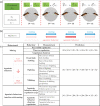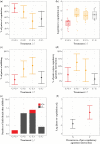Fighting over defense chemicals disrupts mating behavior
- PMID: 35444493
- PMCID: PMC9015217
- DOI: 10.1093/beheco/arab117
Fighting over defense chemicals disrupts mating behavior
Abstract
Studies on intraspecific contest behavior predominantly focus on contests between individuals of the same sex, however contest behavior is also expected to occur between individuals of the opposite sex including possible mates. Here we investigate potential trade-offs between mating and fighting behavior in the turnip sawfly (Athalia rosae). Adults of this species collect chemical defense compounds (clerodanoids) directly from plants but also indirectly by nibbling on conspecifics that have already obtained clerodanoids, a highly aggressive behavioral interaction. An A. rosae individual without clerodanoids may therefore be the potential mate or attacker of an individual of the opposite sex that has gained clerodanoids. To test the effect of clerodanoids on agonistic and mating behavior we paired females and males with or without clerodanoid access in a two-way factorial design. We show that asymmetrical clerodanoid acquisition between female-male pairs causes an increase in agonistic nibbling behavior, irrespective of sex, and moreover that conflict between individuals delays mating behavior. Our study highlights the importance of investigating agonistic intersex interactions, which can occur when adults are able to acquire valuable non-reproductive resources from a potential partner.
Keywords: chemical defense; conflict; dyadic contests; fighting behavior; mating behavior.
© The Author(s) 2021. Published by Oxford University Press on behalf of the International Society for Behavioral Ecology.
Figures


References
-
- Adams SA, Morse DH. 2014. Condition-dependent mate choice of a parasitoid wasp in the field. Anim Behav. 88:225–232.
-
- Amano T, Nishida R, Kuwahara Y, Fukami H. 1999. Pharmacophagous acquisition of clerodendrins by the turnip sawfly (Athalia rosae ruficornis) and their role in mating behavior. Chemoecology 9:145–150.
-
- Andersson M. 1994. Sexual selection. Princeton, NJ: Princeton University Press.
-
- Arnqvist G. 1992. Pre-copulatory fighting in a water strider: inter-sexual conflict or mate assessment? Anim Behav. 43:559–567.
LinkOut - more resources
Full Text Sources

